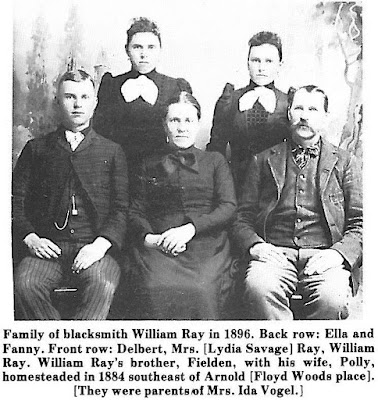Sunday Stories: Arnold in the spring of 1884
Word spread of the new little town on the South Loup, in need of those with a trade. William Ray, a blacksmith, came from Missouri in April – walked from North Platte to Arnold in a day and a half. As he approached the “outskirts” he met “Uncle” Charles Hughey riding Redbird and inquired, “How far is it to Arnold?” The answer was, “See that little soddy? That’s Arnold.” Ray built a story and a half sod house, facing south (east of Spargo corner),and across the road to the south, a sod blacksmith shop, facing north, where he would be for the next eighteen years. Here he built the first “Go-devil” used in this part of the country.
A 24 x 36 frame hardware store, built by Richard A. Probert, went up across the street from Allen’s Pioneer Store (Jameson and Hotel Custer corner).
Sylvester Edwards, a widower from New York, who had come to Arnold in ’83 and was living in a small house near the old Henry Brothers headquarters (Ray Koubek place), built an unusually ornate story and one-half business building for Dave and Joe Blum’s clothing store, to be operated by Dave Blum. The brothers had a similar store in Broken Bow. They, too, were from New York and had some connections with a New York based clothing store interest. The building, originally located on the present Forrester’s garage corner, was moved in ’86 to where the Model Café now is. It faced the west and served as the town’s bank until 1905.
John Owens, a land agent, built a 20 x 38 farm machinery building (Spargo corner), and R. H. Miller, a printer, established a print shop for his short-lived “Arnold Standard” on the lot across the road north of the Pioneer Store (Finch Drug corner).
Marion Nycum hauled lumber from Cozad for a livery barn, located east of Leland’s mill (Masonic Temple site), complete with corrals and a small office. Nycum hired his nephew, young Will Beltz, to help around the barn. Farmers bringing corn or wheat to the mill could park their wagons and camp on the open place between the two establishments. For most this was a two day trip, and although it ran day and night, each man had to wait his turn at the mill. Drivers slept in the livery’s hay mow.
Flour was made at both Arnold and Milldale until 1894, when drought years cut the wheat crop, but even when crops picked up, the making of flour was not resumed until a brief period about 1919. Feed was ground at both mills until about 1910.
At the time the mill was built, Sam Leland put up a small frame house across the river west of it, and in 1884, sold his interest in the mill to John F. Koch.
Koch built a sod house east of the mill (about a block south of the post office). He had worked for the Lelands and Harrises when they had a mill at Alexandria, Nebraska, and knew the business. They ground with old-fashioned stone burrs and he was an expert at sharpening them, patiently chipping away with a steel chisel set in a wooden handle. These chisels were about ten inches long, both ends sharpened, with a square shank in the middle for attaching the handle. The burrs were set in a metal housing so one could be raised or lowered to grind fine or course. Three of the original burrs were used as stepping stones by Stephen Leland’s son, Alonzo, when he moved into his father’s house about 1919, and one has survived intact to the present time.






502DF930CD
ReplyDeleteTakipçi Satın Al
En İyi Animasyon Filmleri
Manga Oku TR